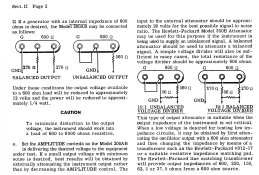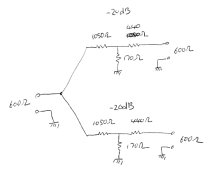noacronym
Member
- Joined
- Mar 17, 2013
- Messages
- 245
- Format
- Multi Format
Thank you for allowing this post to remain. I have a technical question related to electronics and post it here because I think I know of a few folks who can answer me most correctly (insert my respect here). I would like to ask anyone who knows how to draw me up a little circuit to divide the signal from an HP 200 ABR into stereo so that I can run the signal into the inputs of tape recorders to align their circuits and heads. Typically, the line in would be 0db or .775 volts. But I do not know what kind of little resistor/capacitor arrangement I would need to fabricate. The HP ABR has a 600Ω output. I am providing a page from the manual. Thank you.The power output as listed in the HP 200 ABR manual is 1 watt or 24.5 V into a 600 ohm load
Attachments
Last edited by a moderator:












